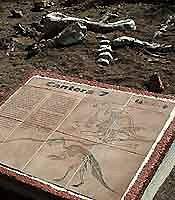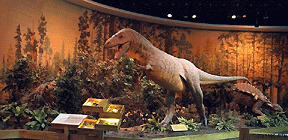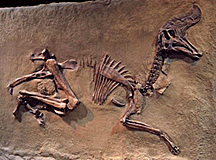DALLYING
IN DINOSAURS
by Wendy A. Luft
 I’m
going to visit Saltillo, I announced. I confess I didn’t have the
foggiest idea why, but basically I’m always ready to travel any place,
any time. I’m
going to visit Saltillo, I announced. I confess I didn’t have the
foggiest idea why, but basically I’m always ready to travel any place,
any time.
The little I knew about Saltillo had nothing to do with what you
would call tourist attractions. In fact, I didn’t even know if
Saltillo had any tourist attractions. I’d seen – but never liked –stiffly
woven, gaudily colored so-called "Saltillo serapes" peddled in
shops in the border towns. I’d heard Saltillo referred to as "The
Athens of the North," because it has a number of good educational
institutions, and "Mexico’s Detroit," because two important
automobile assembly plants are located there. I’d also seen -- and
admired-- Saltillo Tile, that rich chocolate-colored floor covering that
adorns the floors of so many homes in the southwestern US, and that, it
turns out, is actually manufactured in Saltillo. I’d also heard that
the city is known for its benign climate, making it a popular weekend
getaway for the people of Monterrey, where the weather is much more
extreme, even though the two cities are only an hour or so apart.
Well, now I’ve been there and I can give you several excellent
reasons for visiting Saltillo…
Museo del Desierto
 There’s
the Museo del Desierto,
a stunning, visitor-friendly museum, with exhibits that explain every
aspect of desert life including the interaction between plants and
animals and how they adjust to lack of water; the rituals and customs of
the nomadic groups that inhabited the area some 12,000 years ago; and
the arrival of the Spanish conquistadors and the railroad (a ticket on
the railroad allowed passengers to hunt down one buffalo from the moving
train, which explains one of the reasons why the species became
extinct). One gallery contains models of dinosaur skeletons, including
Isauria a duck billed dinosaur that was the first of the species
collected and mounted in Mexico (this particular specimen, that was
found in the desert not far from Saltillo, was named after a popular
actress from Coahuila state). There’s also a colony of live, adorable
prairie dogs, that looked as if they stepped out of a Dr. Seuss
storybook, a botanical garden with some 400 varieties of cacti, plus a
water patio where it "rains" every 14 minutes – very
refreshing after the three-hour tour! All the explanations of the
exhibits are in Spanish, but an English-language guide sheet available
in the ticket office is helpful. There’s
the Museo del Desierto,
a stunning, visitor-friendly museum, with exhibits that explain every
aspect of desert life including the interaction between plants and
animals and how they adjust to lack of water; the rituals and customs of
the nomadic groups that inhabited the area some 12,000 years ago; and
the arrival of the Spanish conquistadors and the railroad (a ticket on
the railroad allowed passengers to hunt down one buffalo from the moving
train, which explains one of the reasons why the species became
extinct). One gallery contains models of dinosaur skeletons, including
Isauria a duck billed dinosaur that was the first of the species
collected and mounted in Mexico (this particular specimen, that was
found in the desert not far from Saltillo, was named after a popular
actress from Coahuila state). There’s also a colony of live, adorable
prairie dogs, that looked as if they stepped out of a Dr. Seuss
storybook, a botanical garden with some 400 varieties of cacti, plus a
water patio where it "rains" every 14 minutes – very
refreshing after the three-hour tour! All the explanations of the
exhibits are in Spanish, but an English-language guide sheet available
in the ticket office is helpful.
After visiting the museum we had another opportunity to get close to
dinosaurs. We drove out to the town of Rincón Colorado, about an hour
due west of Saltillo.
Museo Paleontológico
de Rincón Colorado
 Surprisingly,
this dusty, thoroughly uninviting spot in the middle of the desert is
totally unremarkable except for the fact that it is home to the Museo
Paleontológico
de Rincón Colorado.
And why would a museum of paleontology be located here? Because just a
few minutes away is the site where paleontologists found the fossilized
skeleton of Isauria, the duck-billed dinosaur, a copy of which is on
display in the Desert Museum (the original is in the Museum of Natural
History, in Mexico City). They’ve also found bones and skulls of
several other species and the largest impression of dinosaur skin ever
found. Surprisingly,
this dusty, thoroughly uninviting spot in the middle of the desert is
totally unremarkable except for the fact that it is home to the Museo
Paleontológico
de Rincón Colorado.
And why would a museum of paleontology be located here? Because just a
few minutes away is the site where paleontologists found the fossilized
skeleton of Isauria, the duck-billed dinosaur, a copy of which is on
display in the Desert Museum (the original is in the Museum of Natural
History, in Mexico City). They’ve also found bones and skulls of
several other species and the largest impression of dinosaur skin ever
found.
As our guide, we were very fortunate to have Dr. René Hernández, a
paleontologist who has devoted his life to studying this part of what is
known as the Chihuahua Desert -- parched land for as far as the eye
could see, interspersed with an amazing variety of cacti and other
desert plants, and fragments of pinkish rock. René reached down and
picked up one of the pieces of rock. Clearly visible was the outline of
an ammonite, a precursor to the snail! Another contained the fossilized
remains of a fish. In the middle of the desert? Before and during the
early Cretaceous Period, René explained, this area was covered on
several occasions by the ocean. During the mid Cretaceous Period, the
ocean began to recede leaving a swampy environment where dinosaurs
thrived. That was about 75 million years ago! When man started to
inhabit this area, some 14,000 years ago, this same land was covered by
a forest. A word of warning: the sun and glare can be brutal so be
certain to wear a hat, sunglass, and smear on lots of sun block.
Museo de las Aves de
México
No less impressive is the Museo de las Aves de México
which exhibits the collection – beautifully displayed -- of some 730
different species of birds (about 2,400 specimens), from a tiny
hummingbird to a magnificent specimen of an eagle in flight, that were
amassed over 40 years by Saltillo native, ornithologist Aldegundo Garza
de León. One of the most outstanding features of the museum is its
corps of guides, made up of ten volunteer students, ranging in age from
nine to 15! Ours was an 11-year-old girl named Roselin, very serious,
but she really knew her stuff! Not only did she offer interesting
explanations of each exhibit, but she was able to field questions
without hesitation.
For a true taste of life in almost any Mexican town or city, a visit
to the zocalo, or main square, is a must. Life tends to revolve around
the plaza and. Saltillo is no exception. Its zocalo, called Plaza de
Armas, is a tree-shaded park with an abundance of benches, that is
flanked by the cathedral on one side and the Government Palace on the
other. Sadly, modernization has destroyed much of the city’s original
architecture and flavor, but several examples of its early colonial life
remain in the downtown area. The 18th century Catedral de Santiago is
considered one of the finest examples of Churrigueresque architecture in
North America. Its centerpiece is a sterling silver altar base dating
from 1608 that was exhibited in "Thirty Centuries of Mexican
Art." Other points of interest in Saltillo are the Vito Alessio
Robles Cultural Center, with a mural illustrating the history of
Tlaxcala that is remarkable only because mural art is almost the
exclusive terrain of men and this one was painted by a woman, Elena
Huerta. There’s also Alameda park, a quiet, tree-shaded spot
containing the Pond of the Republic, which is built in the shape of
Mexico, and an impressive equestrian statue of General Ignacio Zaragoza.
El Serape de Saltillo
While downtown, take the time to visit El Serape de Saltillo they make
authentic Saltillo serapes that aren’t anything like the rip offs I’d
seen in souvenir shops along the border. They are made from fine
hand-spun and dyed wool, on the same type of looms that the Tlaxcalan
Indians brought with them when they were imported to this area in the
16th century to help the Spanish settlers control the inhospitable
Plains Indians. The serapes feature a striking central design and
geometric border and the clever use of about six different tones of each
of the brilliant colors gives the serapes an almost three-dimensional
quality. They aren’t inexpensive, but they make a really unique rug or
wall hanging, as well as a cherished souvenir of a memorable trip. |

